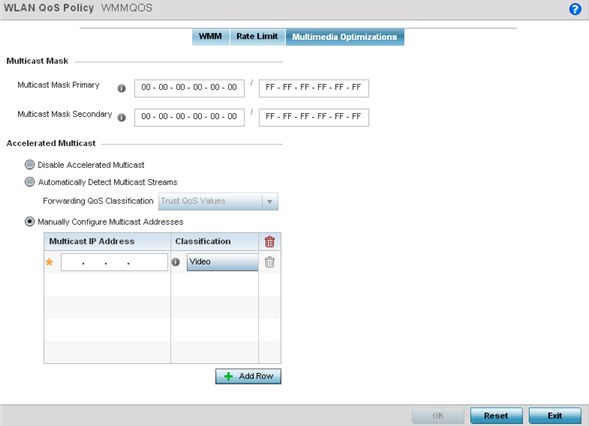To configure a QoS rate limit configuration for a WLAN:

| Multicast Mask Primary | Configure the primary multicast mask defined for each listed QoS policy. Normally all multicast and broadcast packets are buffered until the periodic DTIM interval (indicated in the 802.11 beacon frame), when clients in power save mode wake to check for frames. However, for certain applications and traffic types, an administrator may want the frames transmitted immediately, without waiting for the DTIM interval. By configuring a primary and secondary multicast mask, an administrator can indicate which frames are transmitted immediately. Setting masks is optional and only needed if there are traffic types requiring special handling. |
| Multicast Mask Secondary |
Set a secondary multicast mask for the WLAN QoS policy. Normally all multicast and broadcast packets are buffered until the periodic DTIM interval (indicated in the 802.11 beacon frame), when clients in power save mode wake to check for frames. However, for certain applications and traffic types, an administrator may want the frames transmitted immediately, without waiting for the DTIM interval. By configuring a primary and secondary multicast mask, an administrator can indicate which frames are transmitted immediately. Setting masks is optional and only needed if there are traffic types requiring special handling. |
| Disable Multicast Streaming | Select this option to disable all accelerated multicast streaming on the WLAN. |
| Automatically Detect Multicast Streams | Select this option to have multicast packets converted to unicast to provide better overall airtime utilization and performance. The administrator can either have the system automatically detect multicast streams and convert all detected multicast streams to unicast, or specify which multicast streams are converted to unicast. When the stream is converted and queued for transmission, a number of classification mechanisms can be applied to the stream, and the administrator can select the desired classification type. Use the Forwarding QoS Classification drop-down list to select the classification to use. |
| Manually Configure Multicast Addresses | Select this option and specify a list of multicast addresses and classifications. Packets are accelerated when the destination addresses matches. |